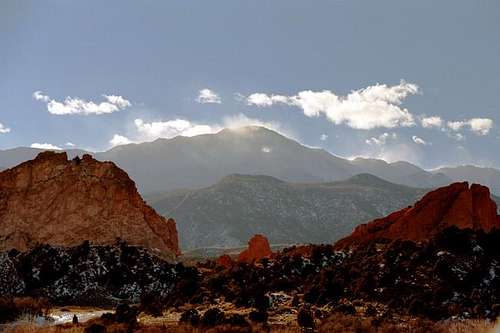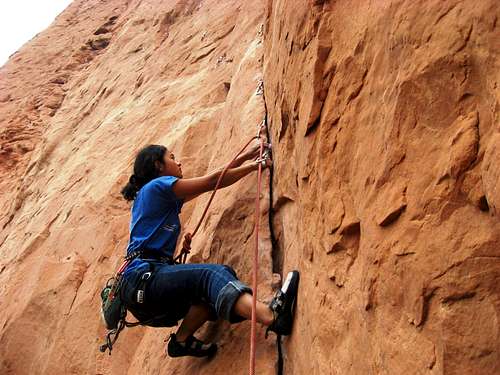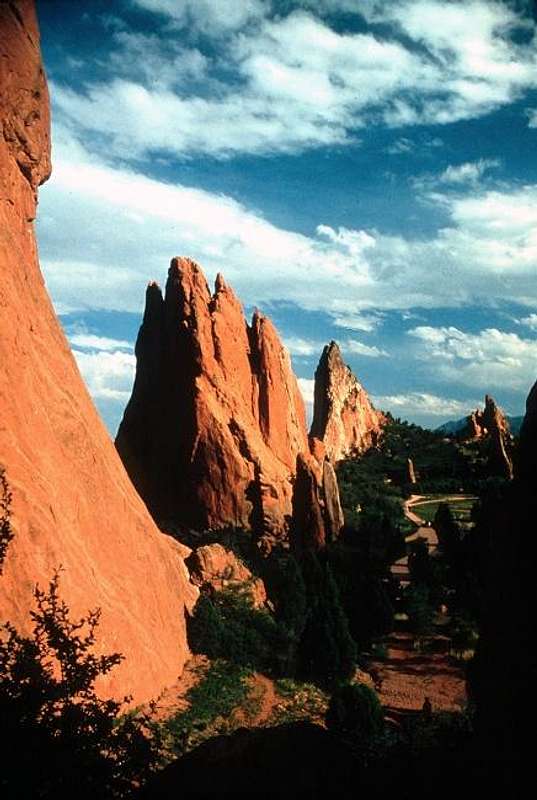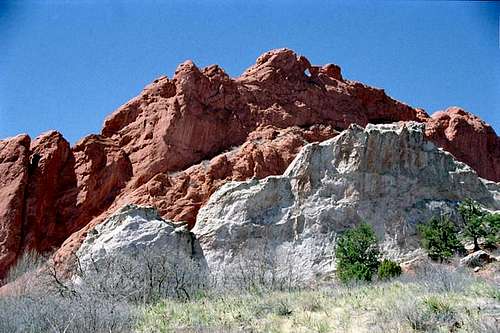|
|
Area/Range |
|---|---|
|
|
38.87780°N / 104.88°W |
|
|
Hiking, Trad Climbing, Sport Climbing, Toprope, Bouldering, Scrambling |
|
|
Spring, Summer, Fall, Winter |
|
|
6400 ft / 1951 m |
|
|
Introduction
Welcome to the Garden of the Gods page on Summitpost! Because this area has over one hundred routes, it would be nearly impossible to comprehensively cover them all. I've added about a dozen routes that I was very familiar with, but there is lots of room here to add more. Please add any other routes, and please send me a PM with corrections or additions to the main page information.
Thanks!
Overview
Garden of the Gods is one of the most famous attractions for technical rock climbers in Colorado. It is also a popular tourist attraction for visitors to Southern Colorado and the City of Colorado Springs. Under the shadow of Pikes Peak,Garden of the Gods is a city park filled with red sandstone spires that defy the imagination. Millions of visitors come to marvel at the formations each year, and plenty of climbers flock to the area to challenge the classic and historic routes in the park. The park is very easily accessed and offers a playground of rock for the technical climber. Almost every route in the park is traditional.
This remarkable climbing area has all sorts of climbing, from friction slabs to finger cracks, all within a few square miles. There are fantastic beginner routes, and extremely tough testpieces for experts. The Garden is truly one of the most unique and beautiful climbing areas in the US.
Getting There
Garden of the Gods is located on 30th Street in Colorado Springs. The easiest way to reach the park from the center of Colorado Springs is to travel West on Colorado Avenue (from downtown) to Old Colorado City. In Old Colorado City, turn north onto 30th street. The park will be obvious as you approach. The Visitor's Center is on the East side of 30th Street, and the park is on the West side.
Click Here for a Road Map from the Visitors Center.
History of Garden of the Gods
Park History
In 1871, General William Jackson Palmer founded Colorado Springs while extending the lines of his Denver and Rio Grande Railroad. In 1879, General Palmer repeatedly urged his friend, Charles Elliott Perkins, the head of the Burlington Railroad, to establish a home in the Garden of the Gods and to build his railroad from Chicago to Colorado Springs. Although the Burlington never reached Colorado Springs directly, Perkins did purchase two-hundred and forty acres in the Garden of the Gods for a summer home in 1879.
He later added to the property but never built on it, preferring to leave his wonderland in its natural state for the enjoyment of the public. Perkins died in 1907 before he made arrangements for the land to become a public park, although it had been open to the public for years. In 1909, Perkins' children, knowing their father's feeling for the Garden of the Gods, conveyed his four-hundred eighty acres to the City of Colorado Springs. It would be known forever as the Garden of the Gods.
"Where it shall remain free to the public, where no intoxicating liquors shall be manufactured, sold, or dispensed, where no building or structure shall be erected except those necessary to properly care for, protect, and maintain the area as a public park."
The Name "Garden of the Gods."
In August, 1859, two surveyors started out from Denver City to begin a townsite, soon to be called Colorado City. While exploring nearby locations, they came upon a beautiful area of sandstone formations. M. S. Beach, who related this incident, suggested that it would be a "capital place for a beer garden" when the country grew up. His companion, Rufus Cable, a "young and poetic man", exclaimed, "Beer Garden! Why it is a fit place for the Gods to assemble. We will call it the Garden of the Gods." It has been so-called ever since.
Native Americans and the Park
There is no good evidence that the Natives of the Colorado Springs region held the Garden with any sort of religious significance. However, evidence of many Native cultures are within the park, and legends abound:
Two alleged Indian legends have come to light concerning the origin of the rocks in the Garden of the Gods. The first was printed by Marion E. Gridley in Indian Legends of American Scenes. It tells the story of a great flood which covered all but the top of Manitou's Mountain, known today as Pikes Peak. When the waters subsided, the Great Spirit turned the floating carcasses of the drowned animals into sandstone, and rolled them down the peak into a garden valley below, where they "remained as mute evidence of the Great Flood."
The second legend was compiled a half century ago by Ford C. Frick, and placed on file at the Pioneers Museum, Colorado Springs, Colorado:
"In the nestling vales and on the grassy plains which lie at the foot of the Great White Mountain that points the way to heaven lived the Chosen People. Here they dwelt in happiness together. And above them on the summit of the Mighty Peak where stand the Western Gates of Heaven, dwelt the Manitou.
"And that the Chosen People might know of his love the Manitou did stamp upon the Peak the image of his face that all might see and worship him....
"But one day as the storm clouds played about the Peak, the image of the Manitou was hid...And down from the North swept a barbaric tribe of giants, taller than the spruce which grew upon the mountain side and so great that in their stamping strides they shook the earth.
"And with the invading host came gruesome beasts - unknown and awful in their mightiness- monstrous beasts that would devour the earth and tread it down....
"And as the invading hosts came on the Chosen Ones fell to the earth at the first gentle slope of the mountain and prayed to Manitou for aid. Then came to pass a wondrous miracle. The clouds broke away and sunshine smote the Peak. and from the very summit, looking down, appeared the face of Manitou himself. And stern he looked upon the advancing host, and as he looked the Giants and the beasts turned into stone within their very steps....
"And when the white men came they called the spot the Garden of the Gods...but we who know the history of the race still call it 'Valley of the Miracle,' for here it was that Manitou gave aid to save his chosen people...."
-Ford C. Frick, placed on file at the Pioneers Museum, Colorado Springs, Colorado.
Hidden Petroglyphs in the Park
The Old Ute Trail: This trail was used by the Ute people to travel to and from the park.
Climbing in Garden of the Gods
Basic Information
Routes in the Garden range from 40 to 400 feet in length, and range from 1-8 pitches in length. The rock becomes very fragile when wet, and climbers must not climb after a rain or snow storm. Much of the fixed protection in the Garden consists of soft angle pitons inserted into drilled holes. Garden veterans all have stories of these pitons pulling out occasionally. Many are very old.
The climbing is varied in this remarkable park. You'll find everything from slabby friction fests to classic crack climbing.
Climbing History in Garden of the Gods
The Garden is one of the oldest established climbing areas in the United States. Albert Ellingwood, a Rhodes Scholar and Colorado College Professor, was the first person to climb technical routes in the Park. Many of his classic routes from the 1920s are still climbed today, using vastly different gear! This climbing pioneer brought techniques from Europe to Colorado, and his name is immortalized on several famous routes around the state. The 14er Ellingwood Point bears his name, as well as the Ellingwood Ridge on La Plata Peak, and the Ellingwood Arete on Crestone Needle.
Ellingwood's understudy, Bob Ormes also established many of the classic routes here. Later, in the 1940s, Vernon Twombly and Stanley Boucher put up several more classics, including the Practice Slab on South Gateway.
The 1950s brought a new revolution to the Garden. Harvey Carter, using new techniques such as drilled angles, established more routes. Also, Army climbers from nearby Fort Carson put up more famous routes like Montezuma's Tower, the West Point Crack, and The Three Graces.
From the 1970s to today, new routes exploded everywhere in the Garden, and modern free climbing techniques reign. Building on their forefathers, modern climbers have set up testpieces to challenge the best climbers in the world.
Climbing Areas in Garden of the Gods
This section is an overview of the main climbing areas and rocks within the park. Please refer to this section to see where to find attached routes.

This map shows the location of Main Climbing Areas referred to below.
The Red and White Twin Spires
These twin spires offer several interesting one pitch climbs. They are located in the center of the park, and are easily accessed by sidewalk by walking around North Gateway Rock from the parking area. A sidewalk circles the twins, and if you climb here, expect tourists to watch you the entire time. Large crowds sometimes gather here.
White Spire:
This 55 foot tall spire is composed of White Fountain Sandstone, and is on the West side of the twins. The White Spire has several classics, and some nice toprope possibilities.
Routes:
North Ridge White Spire (5.7)
West Face White Spire (5.8)
South Ridge White Spire (5.6)
Red Spire:
The Red Spire is a 60 foot pinnacle, and comprises the East side of the twins.
Routes:
Potholes (5.7)
Incline Ledge (5.8)
Montezuma's Tower
This is one of the classic routes of the Park. Two exposed pitches on an amazing, free standing pinnacle to an airy summit.
Route: Montezuma's Tower (5.7)
North Gateway Rock
This is the formation closest to the parking area, but the face that hovers over parking is off-limits to climb. This is the largest formation at the Garden, and has some of the best sandstone. The longest route at the garden, 8 pitches, is on N. Gateway.
Cowboy Boot Face
This face is 100 feet high and is very popular.
Routes:
Cowboy Boot Crack (5.6)
Fastest Drill (5.9)
Tourist Gully
The Tower of Babel
This north-facing pinnacle is the northernmost climbing area on North Gateway. This amazing, triple summited tower has a diverse blend of routes.
Routes:
Anaconda (5.10c)
The West Face
About 30 routes here, mostly friction climbs.
Finger Face
Lots more routes here, mostly face climbs. Usually well-protected.
South Gateway Rock
South and North Gateway are split by a sidewalk. It is 250 feet high, and is composed of Lyons Sandstone. This immense rock has many great routes.
The Drug Wall
This wall is on the Northeast side of South Gateway. It has several creatively named routes referring to illicit drugs.
Routes:
Cocaine (5.10d)
Candyman (5.10d)
Silver Spoon (5.5)
The West Face
This wall obviously on the West face of South Gateway. There are several one to three pitch routes on the face.
Routes:
West Point Crack (5.7)
The Practice Slab (5.1 - 5.8)
The Three Graces
The Graces are a three fin pinnacle just to the West of Montezuma's Tower. They are aesthetic, and easily accessed by a classic 5.2 route, Windows. Last year, a climber died here when his protection ripped out of the wet rock.
Route: Windows (5.2)
Balanced Rock
Balanced Rock isn't a climbing area, but is well worth your time. It will blow your mind.
Route:Balanced Rock
Cathedral Rock / Grey Rock / Kindergarten Rock
This imposing formation has the confusion of three names. This formation has some of the best routes in the area, on some of the best rock. It's also a little removed from the main area, so you're less likely to have a flock of tourists watching your every move.
East Face, South Summit
The south summit routes are much better, generally, than the northern routes. This area has many difficult routes, and some are sport-bolted.
Routes:
New Era (5.7)
End of an Era (5.9)
Diesel and Dust (5.11a)
East Face, North Summit
Most of the routes here are dangerous and loose, requiring R ratings. All protection here is questionable. Always use a helmet here and climb at your own risk.
West Face
The West Face has two parts - the section below the North Summit, and the one below the South Summit. As described above, the area below the South Summit is much better, solid rock.
Keyhole Rock
This formation has a bunch of great routes - I think they are all one-pitchers. The routes go all the way around the formation. The rock here is generally solid. This formation is climbed less than the others in the park, so anchors may be older and less maintained. Use caution.
Easter Rock
Easter Rock is between Keyhole and Kindergarten. It is seldom climbed because it is very loose and crumbly, and offers almost no protection at all. Most of the routes have an R rating. There is a two bolt anchor on top for rapping.
Red Tape
Garden of the Gods Park Hours
5am - 11pm (Summer)
5am - 9pm (Winter)
Garden of the Gods Visitor Center and Nature Center Hours
8am - 8pm (Memorial Day weekend through Labor Day weekend)
9am - 5pm (Winter)
Closed Thanksgiving, Christmas, and New Years Day.
Both the Park and the Visitor's Center are free and open to the public year-round.
Rock Climbing Regulations
Rock Climbers must first register at the Garden of the Gods Visitor & Nature Center. Technical climbing is permitted on established routes, in groups of two or more. Proper climbing equipment is mandatory and the use of eco-chalk is recommended. All other climbing or rock scrambling in Garden of the Gods Park is illegal. If slings are left, they must match the natural color of the rock.
Dogs
Dogs are allowed in the Garden of the Gods Park on a six foot leash. There is one designated area where dogs can run unleashed – south of Gateway Road and West of 30th Street. Owners are responsible for cleaning up after their dogs in all areas of the Park.
Mountain Biking
Mountain biking is allowed on designated mountain biking trails in the Garden of the Gods Park. Remember, you will be sharing these trails with equestrian users and hikers. Please abide by the regulations outlined in the mountain biking brochure, available at the Visitor & Nature Center. In addition, all one-way roads in the Park have paved biked lanes.
Hiking
Hikers are encouraged to stay on the main trails, which are well-marked. Free trail maps are available in the Visitor's Center.
When To Climb
Garden of the Gods, subject to the City Park hours of operation, can be climbed year-round. The weather in Colorado Springs often affords technical climbing even in the dead of winter.
The sandstone rock at Garden of the Gods is extremely dangerous when it is wet. It becomes very loose when wet. For your own safety and to preserve the rocks, do not climb when it is wet. This might require you to wait a few days after a snow or rain storm to climb safely.
Camping
This is a city park with hours of operation, so there is no camping permitted in the area.
Weather and Contact Info
The Garden of the Gods Visitors' Center can be reached at 719-634-6666.
Weather: NOAA Forecast for Colorado Springs.















